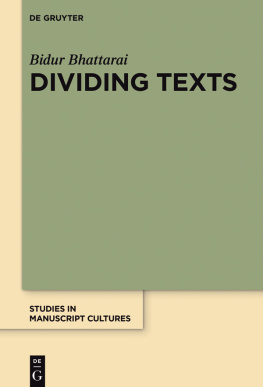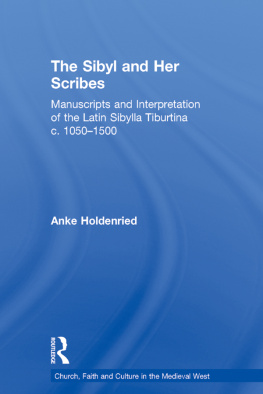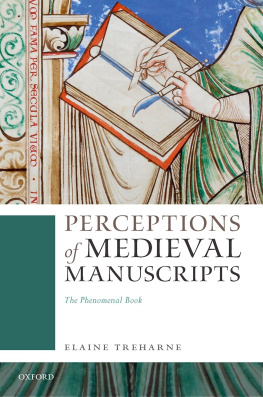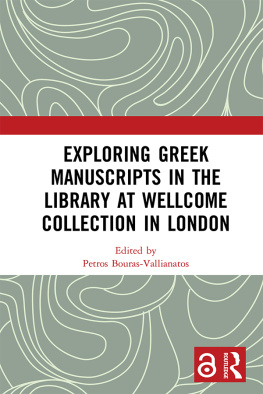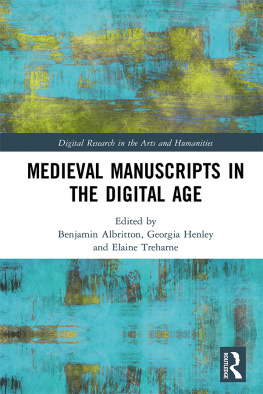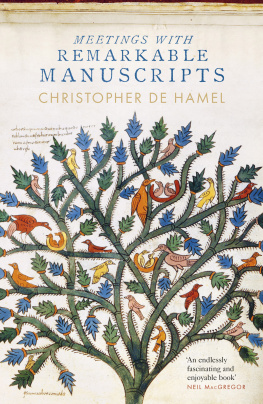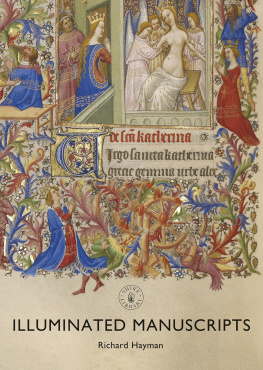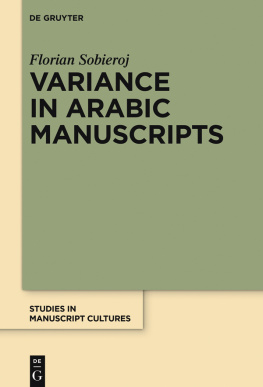One-Volume Libraries: Composite and Multiple-Text Manuscripts
Guide

One-Volume Libraries: Composite and Multiple-Text Manuscripts
Studies in Manuscript Cultures

Edited by Michael Friedrich Harunaga Isaacson Jrg B. Quenzer
Volume 9

ISBN 978-3-11-049693-2
e-ISBN (PDF) 978-3-11-049695-6
e-ISBN (EPUB) 978-3-11-049559-1
ISSN 2365-9696

This work is licensed under the Creative Commons Attribution-NonCommercial-NoDerivs 3.0 License. For details go to http://creativecommons.org/licenses/by-nc-nd/3.0/.
Library of Congress Cataloging-in-Publication Data
A CIP catalog record for this book has been applied for at the Library of Congress.
Bibliographic information published by the Deutsche Nationalbibliothek
The Deutsche Nationalbibliothek lists this publication in the Deutsche Nationalbibliografie;
detailed bibliographic data are available on the Internet at http://dnb.dnb.de.
2016 Michael Friedrich, Cosima Schwarke, published by Walter de Gruyter GmbH, Berlin/Boston.
The book is published with open access at degruyter.com.
www.degruyter.com
Michael Friedrich and Cosima Schwarke
Introduction Manuscripts as Evolving Entities
manuscripts [] do not stand still but develop .
Johan Peter Gumbert
The title of this collective volume pays tribute to the eminent Arabist Franz Rosenthal (19142003). He described in one of his notes From Arabic Books and Manuscripts a manuscript written in 148788 by a learned bookseller from Yemen, who had compiled the volume for his own use:
The intellectual outlook of an-Nihm is revealed by the contents of the manuscript which he wrote for himself. He appears to have considered it as the repository of what he thought was most valuable in the world of literature. Mysticism and philosophy take the first place, and there is a strong and unmistakable inclination for the occult sciences. But an-Nihm also shows some historical and poetical interest. Above all, he displays a courageous willingness to make his choice of literary works with a remarkable disregard of religious barriers and traditions.
This Brief Communication on a One-Volume Library of Arabic Philosophical and Scientific Texts in Istanbul was published in 1955 and, despite its promise of conceptual richness, only recently seems to have inspired further research.
The same holds true for a short article by Lynn Thorndike (18821965), author of the famous eight-volume History of Magic and Experimental Science . In contrast to copies mass-produced by the pecia system for the European universities since the 14 th century, he had described manuscripts which consisted of more than one text and had been produced by or for an individual who desired to have in a single volume a number of relatively brief treatises by different authors of his own selection as early as 1946:
Since this was his own affair, he might alter the word order or even the wording of his authors to make the meaning clearer or the style more acceptable to himself, or just because he was a bit careless and indifferent as to such matters. He might purposely omit some of the text which did not seem to him worth the trouble of copying, or condense it a little, or expand it a little, or embody a previous marginal note in the text, or add a new note of his own, or make such other alterations as he chose. He might know the authors and titles of the works which he was copying so well that he would not bother to record them. He might insert anonymously a composition of his own.
So, while the exemplar [in the pecia system] was a single text which aimed to be standard divided into handy pieces, the ordinary learned Latin manuscript is often a composite of different treatises in all sorts of permutations and combinations, not merely of selection and arrangement of the component treatises, but in the characteristics and peculiarities of the text of each. []
Such manuscripts combine within one cover a working library with a laboratory notebook or a clinical record of cases. Or they may reflect the professional interests of a lawyer or logician or theologian or astronomer and astrologer. Others are commonplace books displaying a miscellaneous literary interest. In all these instances what is left out may be as significant and revealing as what is included. The personal liberties which the maker of the new manuscript has taken with the old texts also have their import. There is a field open to conjecture not only why certain treatises have been included but why this or that particular extract from a past work was made. If the manuscript was not put together for professional purposes and does not deal with any one special field of knowledge exclusively, its combination of subjects provides further food for thought as to the type of mind back of this conglomeration of ideas. Why were these treatises on different topics thus brought together? This last question may also to be asked in the case of manuscripts written in different hands or of which the component parts were bound together at a later date. Why were they bound together? []
There may further be significance in the order in which related works occur, although, as far as my knowledge goes, there is likely to be more variety than uniformity in this respect.
This article is worth being quoted in length, since it elegantly sketches a research programme which after seventy subsequent years later is still in the process of being implemented. Both one-volume library and working library convey the same idea of an individual collection of texts in one book that contains all its scribe or patron might need for professional or other purposes. In some cases such a one-volume library might even represent a real library or parts of it.
While Rosenthal was mainly concerned with the texts of his manuscript, Thorndike already indicated the basic distinction between text and material object: some manuscripts were produced as one book with two or more texts, while others were bound together later and consisted of formerly independent component parts.
In the 1980s, scholars of European medieval literatures showed a growing interest in miscellanies and the concept of miscellaneity. Concepts such as mouvance (Zumthor 1972) method. A call for a new philology was followed by the idea of material philology as outlined by the Romance scholar Stephen G. Nichols:
Material philology takes as its point of departure the premise that one should study or theorize medieval literature by reinserting it directly into the vif of its historical context by privileging the material artifact(s) that convey this literature to us: the manuscript. This view sees the manuscript not as a passive record, but as a historical document thrusting itself into history and whose very materiality makes it a medieval event, a cultural drama.
In 1996, Nichols and the German medievalist Siegfried Wenzel edited The Whole Book: Cultural Perspectives on the Medieval Miscellany which became a milestone for the study of miscellanies in European medieval literary studies. In their introduction they call for attention to the single manuscript as a historical artifact by taking the following into account:


